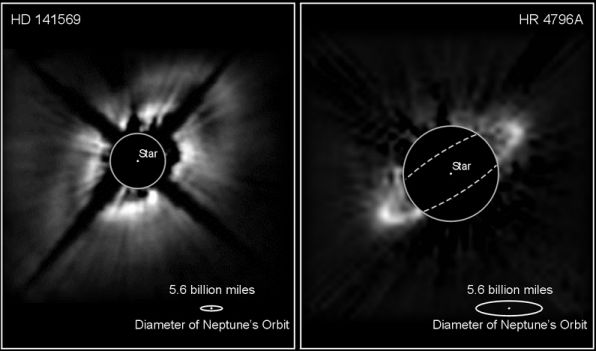
|
Credit & Copyright: Left-
A. Weinberger, E. Becklin
(UCLA),
G. Schneider (U. Arizona),
NASA
Right- B. Smith (U. Hawaii), Glenn Schneider (U. Arizona), NASA
Explanation:
These near-infrared Hubble images of dust
surrounding young stars
offer the latest tantalizing evidence for planets
beyond our Solar System.
At left, the dark
gap seen in the dust disk is reminiscent of a similar
large gap in
Saturn's rings
believed to be sculpted by orbiting moons.
By analogy, the gap in
the dust disk of HD 141569 may be a larger scale
result of unseen orbiting planets.
At right is a relatively thin stellar dust ring
suggestive of planetary rings held in
place by orbiting moons.
On a much larger scale this ring around
the star HR 4796A could also
indicate the presence of orbiting planet-sized bodies too faint to be
directly visible.
For a distance comparison, the orbit of Neptune is drawn at the lower right
of each picture.
The overwhelmingly bright starlight at the center has
been blocked out to reveal the dim dust features.
Right- B. Smith (U. Hawaii), Glenn Schneider (U. Arizona), NASA
|
January February March April May June July August September October November December |
| ||||||||||||||||||||||||||||||||||||||||||||||||
NASA Web Site Statements, Warnings, and Disclaimers
NASA Official: Jay Norris. Specific rights apply.
A service of: LHEA at NASA / GSFC
& Michigan Tech. U.
Based on Astronomy Picture
Of the Day
Publications with keywords: extrasolar planet - dust - infrared - young stars
Publications with words: extrasolar planet - dust - infrared - young stars
See also:
- APOD: 2025 September 8 Á IRAS 04302: Butterfly Disk Planet Formation
- APOD: 2025 August 28 Á Galaxies, Stars, and Dust
- APOD: 2025 February 23 Á Saturn in Infrared from Cassini
- Young Stars, Dark Nebulae
- APOD: 2024 September 29 Á Seven Dusty Sisters
- The Dark Seahorse of Cepheus
- NGC 7023: The Iris Nebula
